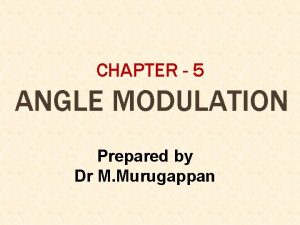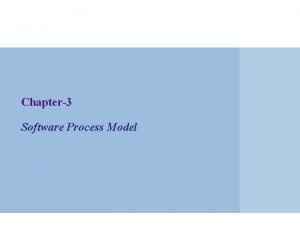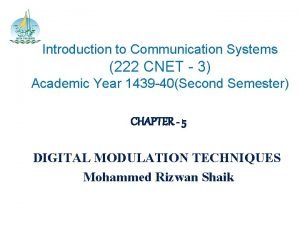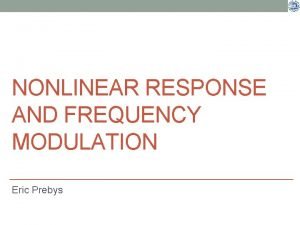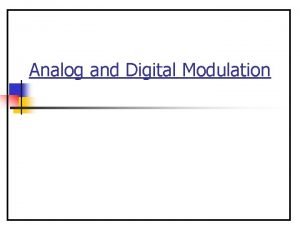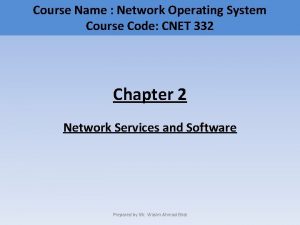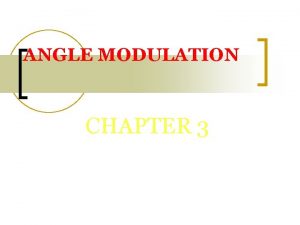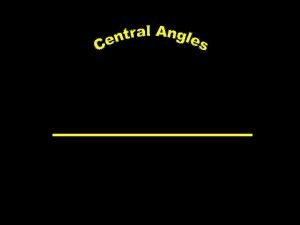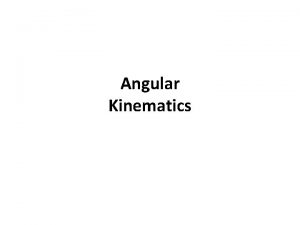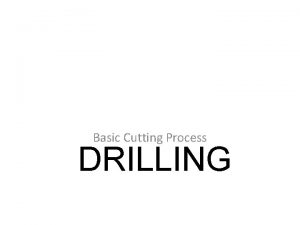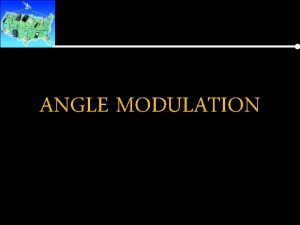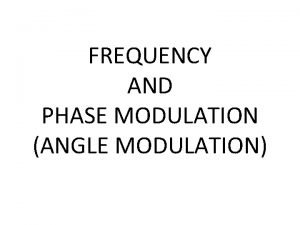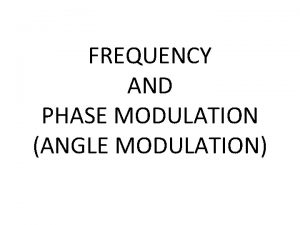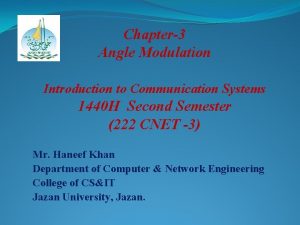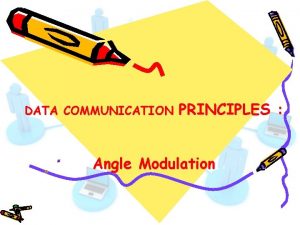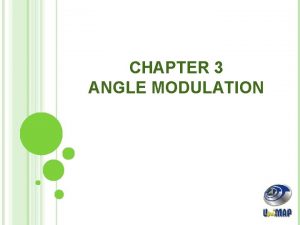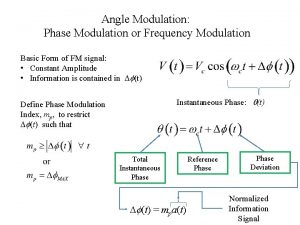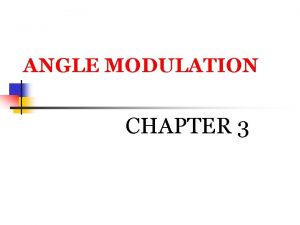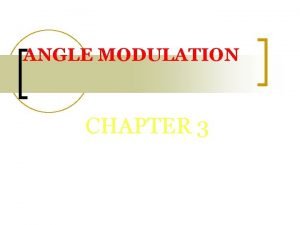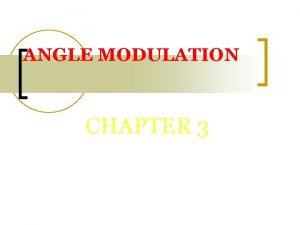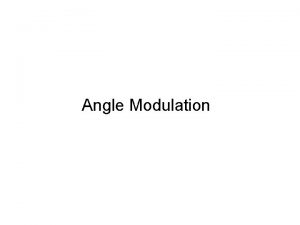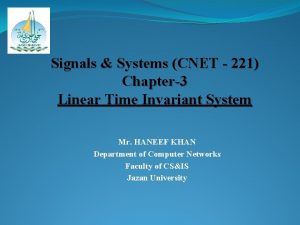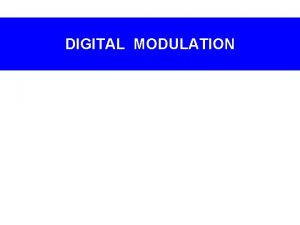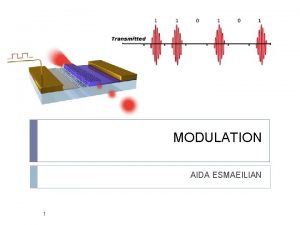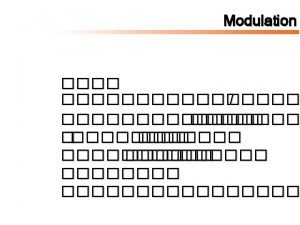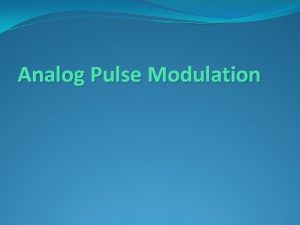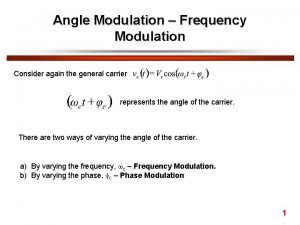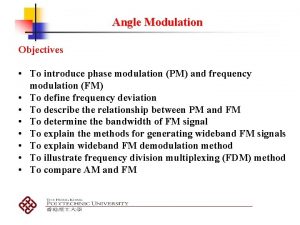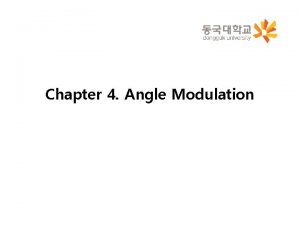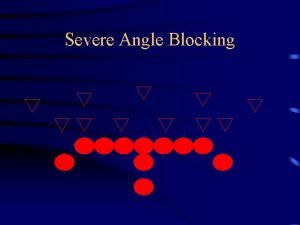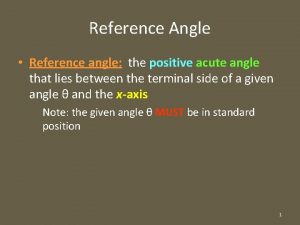Chapter3 Angle Modulation Introduction to Communication Systems CNET
























- Slides: 24

Chapter-3 Angle Modulation Introduction to Communication Systems (CNET - 222) Mr. Haneef Khan Department of Computer Networks College of CS&IS Jazan University, Jazan.

Objectives 1. Analog Modulation and its types. 2. Basics of Sine and Cosine in term of amplitude, frequency and phase. 4. Frequency Modulation concept, equations and waveforms 5. Phase Modulation concept, equations and waveforms. 6. Numerical on FM and PM.

Introduction �There are three parameters of a carrier that may carry information: �Amplitude �Frequency �Phase �Frequency and Phase modulation are closely related and grouped together as phase modulation.

Types of Modulation �Types of Information • Analog • Digital These two constitute angle modulation. Carrier Variations Ø Amplitude Frequency Ø Phase Ø

Sine Signal And Cosine Signal Sine waveform Cosine waveform A sinusoid, meaning a sine wave -or- a cosine wave, is the basic building block of all signals.

What is Amplitude, Frequency, and Phase ? Vary one of these parameters ase Ph q Fre c n ue y p Am d litu e Angle modulation is a variation of one of these two parameters.

Difference between Amplitude, Frequency and Phase

Understanding Phase vs. Frequency V phase To understand the difference between phase and frequency, a signal can be thought of using a phasor diagram. The distance from the center is the signal's amplitude. The angle from the positive horizontal axis is the phase.

Understanding Phase vs. Frequency an (cha ha p e ng ch ( / ) se e) im ge t The change in the phase over time (the phase velocity) is the signal's frequency.

Signals vs NASCAR F In NASCAR, we track each car by its position on the track. In signals, we track the signal by its phase. This is its position on the phasor diagram.

Signals vs NASCAR In NASCAR, we track a car's velocity by how fast it goes around the track. In signals, we track the signal's velocity by its frequency. This is how fast it goes around the phasor diagram.

Frequency Modulation(FM) FM is technique of transmitting message signal using a radio-frequency carrier signal. The frequency of the carrier signal is varied accordance with the amplitude of the message signal, the amplitude of the carrier signal remain unchanged.

FM Waveform

Equations 1. Message Signal vm = Vm sin(ωm + ϕm) 2. Carrier Signal vc = Vc sin(ωct + ϕc) Where, vm , vc = Instantaneous value of message and carrier signal. ωm , ωc = Angular velocity ϕm , ϕc = Phase Angle ωt represent angle in radian.

3. Modulated Signal v. FM = Vc sin(ωct + mf cos ωmt) Where, δf = Maximum deviation mf = Modulation Index = δf /fm

Advantages of FM 1. Resilient to noise. 2. Resilient to signal strength variations. 3. Does not require linear amplifiers in the transmitter. 4. Enables greater efficiency than many other modes. Disadvantages of FM 1. Requires more complicated demodulator. 2. Much more Bandwidth 3. Sidebands extend to infinity either side.

Phase Modulation Phase modulation is a technique or a system in which the amplitude of the carrier signal is kept constant, while phase and rate of phase change are varied with accordance of message signal. The amount by which the carrier phase is varied from its original value, called as the phase deviation.

Waveform of PM

Equations 1. Message Signal vm = Vm sin(ωm + ϕm) 2. Carrier Signal vc = Vc sin(ωct + ϕc) Where, vm , vc = Instantaneous value of message and carrier signal. ωm , ωc = Angular velocity ϕm , ϕc = Phase Angle ωt represent angle in radian.

3. Modulated Signal v. PM= Vc sin(ωct + ϕc +mp cos ωmt) Where, mp = Modulation Index) = δp δp = Maximum deviation

Advantage of PM 1. Phase modulation is increased immunity to noise. 2. Phase modulator is used in determining velocity of moving target by extracting Doppler information. Disadvantages of PM 1. Phase ambiguity comes if we exceed its modulation index pi radian(180 degree). 2. We need frequency multiplier to increase phase modulation index.

Examples


END
 Advantages of angle modulation
Advantages of angle modulation Chapter3
Chapter3 Chapter3
Chapter3 Cnet communication
Cnet communication Cnet3
Cnet3 Amplitude modulation vs frequency modulation
Amplitude modulation vs frequency modulation Amplitude modulation vs frequency modulation
Amplitude modulation vs frequency modulation Cnet syndication
Cnet syndication Cnet
Cnet Cnet ftp
Cnet ftp Angle modulation formula
Angle modulation formula What is aa similarity theorem
What is aa similarity theorem At what angle of incidence is the angle of refraction 90
At what angle of incidence is the angle of refraction 90 First angle projection and third angle projection
First angle projection and third angle projection Angle whose vertex is at the center
Angle whose vertex is at the center Hand cutting instruments in operative dentistry
Hand cutting instruments in operative dentistry Absolute angle vs relative angle
Absolute angle vs relative angle Two acute vertical angles
Two acute vertical angles Bisects ∠fgi. find the measure of ∠hgi.
Bisects ∠fgi. find the measure of ∠hgi. Angle klm and angle mln are a linear pair.
Angle klm and angle mln are a linear pair. Angle bisector worksheets
Angle bisector worksheets Hk bisects ghj
Hk bisects ghj Extinction angle definition
Extinction angle definition Complementary and supplementary angles definition
Complementary and supplementary angles definition The lip clearance angle is the angle formed by the *
The lip clearance angle is the angle formed by the *
